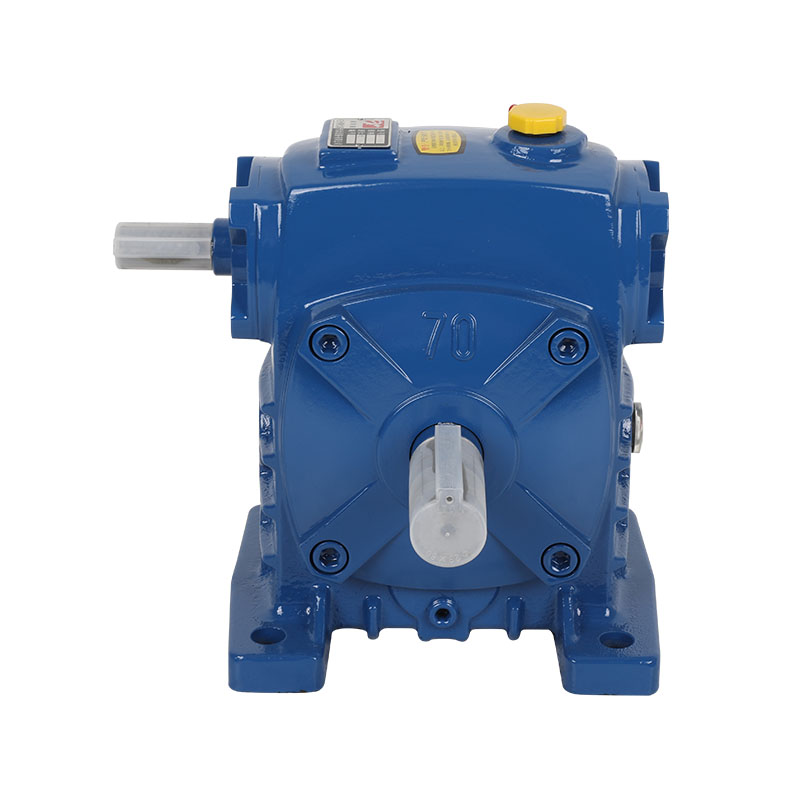Improving the efficiency of WP worm gear reducers is a multifaceted issue involving multiple factors such as design optimization, material selection, manufacturing process and lubrication conditions. Here are some specific improvement methods and technical paths:
1. Optimizing the geometric design of worms and worm wheels
Helix angle optimization:
The helix angle of the worm has a significant effect on the transmission efficiency. A larger helix angle can reduce sliding friction and thus improve efficiency. However, an excessively large helix angle may lead to poor meshing or reduced load-bearing capacity, so it is necessary to find the optimal angle through experiments and simulations.
Tooth profile design:
Using involute tooth profiles or other optimized tooth profile designs (such as double enveloping worms) can improve the contact conditions of the meshing pair, reduce sliding friction and improve transmission efficiency.
Module and pressure angle:
Reasonably select the module and pressure angle to balance the load-bearing capacity and transmission efficiency. A smaller pressure angle can generally reduce friction, but may sacrifice some strength.
2. Material selection and surface treatment
Material matching:
Traditional worms and worm wheels usually use a combination of steel worms and bronze worm wheels. This material combination has good tribological properties, but efficiency can be further improved by introducing high-performance materials such as high-strength steel, carbon fiber reinforced composites or ceramic coatings.
Surface hardening: Surface hardening of the worm (such as carburizing, nitriding or chrome plating) can increase its hardness and wear resistance while reducing the friction coefficient.
Low-friction coating: Coating the worm and worm wheel with low-friction materials (such as molybdenum disulfide, graphene or PVD coating) can significantly reduce sliding friction losses.
3. Improve lubrication conditions
Lubricant selection: The use of high-performance synthetic lubricants (such as polyethylene glycol or ester oils) can improve lubrication, especially under high temperature or heavy load conditions.
Intelligent lubrication system: Design an intelligent lubrication system to dynamically adjust the lubricant supply according to the operating conditions to avoid increased energy consumption caused by insufficient or excessive lubrication.
Self-lubricating materials: Develop self-lubricating materials (such as copper alloys containing graphite or molybdenum disulfide) that can maintain a low friction coefficient when lubrication conditions are insufficient.
4. Thermal management and heat dissipation optimization
Housing design:
Optimizing the heat dissipation structure of the reducer housing (such as adding heat sinks or using aluminum alloy materials) can effectively reduce the operating temperature, thereby reducing lubrication failure and efficiency loss caused by high temperature.
Cooling system:
Under high load or long-term operating conditions, install external cooling devices (such as fans or water cooling systems) to reduce internal temperatures.
5. Reduce internal losses
Bearing optimization:
Using high-performance rolling bearings instead of sliding bearings can reduce friction losses during rotation.
Seal design:
Improve the sealing structure to reduce leakage and friction losses, while preventing impurities from entering the reducer.
Gap control:
Precisely control the meshing clearance between the worm and the worm wheel to avoid energy loss caused by excessive or too small clearance.
6. Manufacturing process and assembly accuracy
Precision machining:
Improve the machining accuracy of the worm and worm wheel (such as through grinding or hobbing processes), ensure the tooth surface finish and meshing accuracy, thereby reducing friction and energy loss.
Assembly error control: Strictly control the axial clearance and radial runout during assembly to ensure the best fit of the gear meshing pair. Heat treatment process: Use advanced heat treatment technology (such as induction quenching or vacuum heat treatment) to improve the strength and wear resistance of parts while reducing deformation.
Through the comprehensive application of the above methods, the transmission efficiency of the WP worm gear reducer can be significantly improved to meet the high performance requirements under different working conditions. If a specific direction needs to be discussed in detail, the research content and technical solutions can be further refined.

 English
English русский
русский bahasa Indonesia
bahasa Indonesia
